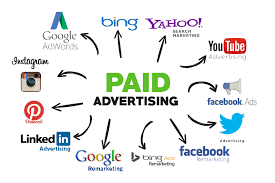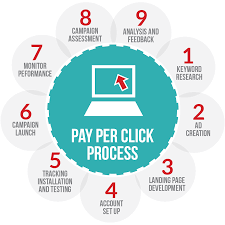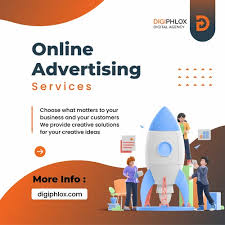Paid Online Advertising: Boost Your Business with Targeted Marketing
In today’s digital age, online advertising has become an essential tool for businesses looking to reach their target audience and drive growth. With the vast number of internet users worldwide, paid online advertising offers a powerful way to increase brand visibility, generate leads, and ultimately boost sales. In this article, we will explore the benefits of paid online advertising and how it can help take your business to new heights.
Targeted Reach:
One of the key advantages of paid online advertising is the ability to target specific demographics, interests, and behaviours. Platforms such as Google Ads and social media advertising allow you to define your target audience based on factors like location, age, gender, interests, and even search history. This level of precision ensures that your ads are shown to people who are most likely to be interested in your products or services, maximizing the return on your investment.
Increased Brand Visibility:
With millions of websites and businesses competing for attention online, standing out from the crowd can be challenging. Paid online advertising provides a solution by placing your brand front and center in relevant search results or social media feeds. By appearing at the top of search engine result pages or as sponsored content on social media platforms, you can increase brand visibility and capture the attention of potential customers who may not have discovered your business otherwise.
Measurable Results:
Unlike traditional forms of advertising where it can be difficult to measure the effectiveness of campaigns accurately, paid online advertising offers robust tracking and analytics tools. These tools provide valuable insights into key metrics such as impressions, clicks, conversions, and return on investment (ROI). With this data at your fingertips, you can continuously optimize your campaigns for better results by tweaking ad copy, targeting parameters or adjusting bidding strategies.
Cost-effective:
Paid online advertising allows businesses of all sizes to compete on a level playing field without breaking the bank. Unlike traditional advertising methods, such as TV or print, where costs can be prohibitively high, online advertising platforms offer flexible budgeting options. You can set daily or monthly spending limits and only pay when someone clicks on your ad (pay-per-click) or when a specific action is taken (pay-per-action). This ensures that your advertising budget is used efficiently, targeting users who are genuinely interested in what you have to offer.
Quick and Flexible:
Paid online advertising provides businesses with the flexibility to launch campaigns quickly and make adjustments in real-time. Unlike traditional advertising channels that require long lead times for production and distribution, online ads can be created and deployed within hours. This agility allows you to respond swiftly to market trends, seasonal promotions, or changes in consumer behaviour.
In conclusion, paid online advertising offers businesses a powerful way to reach their target audience with precision and efficiency. With the ability to target specific demographics, increased brand visibility, measurable results, cost-effective pricing models, and flexibility in campaign management, it’s no wonder that more businesses are embracing this digital marketing strategy. Whether you’re a small startup or an established enterprise, paid online advertising can help drive your business forward by connecting you with the right customers at the right time. So why wait? Start exploring the world of paid online advertising today and unlock new opportunities for growth.
Commonly Asked Questions About Paid Online Advertising in the UK
- How much does online advertising cost?
- What are the benefits of paid online advertising?
- What is the best way to target potential customers with online ads?
- How can I track the performance of my online ads?
- How do I optimise my online ad campaigns for maximum ROI?
How much does online advertising cost?
The cost of online advertising can vary greatly depending on several factors, including the platform you choose, your target audience, the competitiveness of your industry, and the specific goals of your campaign. Here are some common pricing models and factors to consider:
- Pay-Per-Click (PPC): With this model, you pay each time someone clicks on your ad. The cost per click can range from a few cents to several dollars, depending on factors such as keyword competitiveness and ad placement. Platforms like Google Ads and Bing Ads typically use this pricing model.
- Cost-Per-Thousand Impressions (CPM): CPM pricing is based on the number of times your ad is shown (per thousand impressions). This model is commonly used in display advertising or social media advertising campaigns. CPM rates can vary significantly based on factors such as audience targeting options and ad placement.
- Cost-Per-Action (CPA): With CPA pricing, you only pay when a specific action is taken by the user, such as making a purchase or filling out a form. This model is often used for performance-based marketing campaigns and affiliate marketing programs.
- Ad Auctions: Many online advertising platforms use an auction-based system where advertisers bid for ad placements. The cost will depend on the competition for that particular ad space and the quality score of your ads.
It’s important to note that these pricing models are just a few examples, and different platforms may have their own variations or additional options available.
To determine how much online advertising will cost for your specific business, it’s recommended to define your campaign objectives and budget first. Conduct research to understand typical costs within your industry and consult with digital marketing professionals or platforms directly to get more accurate estimates based on your goals.
Remember that while online advertising can be cost-effective compared to traditional forms of advertising, it’s crucial to allocate an appropriate budget that aligns with your business objectives and expected return on investment.
What are the benefits of paid online advertising?
Paid online advertising offers several benefits for businesses looking to enhance their marketing efforts. Here are some key advantages:
- Targeted Reach: Paid online advertising allows you to precisely target your desired audience based on factors such as demographics, interests, location, and search behavior. This ensures that your ads are shown to people who are most likely to be interested in your products or services, increasing the chances of conversion.
- Increased Brand Visibility: With paid online advertising, you can elevate your brand’s visibility by appearing at the top of search engine result pages or as sponsored content on social media platforms. This exposure helps you reach a wider audience and increase brand recognition.
- Measurable Results: Online advertising platforms provide robust tracking and analytics tools that allow you to measure the effectiveness of your campaigns accurately. You can track metrics such as impressions, clicks, conversions, and ROI. This data helps you understand the performance of your ads and make data-driven decisions for optimization.
- Cost-effective: Paid online advertising offers flexible budgeting options suitable for businesses of all sizes. You can set spending limits and only pay when someone interacts with your ad (pay-per-click) or performs a specific action (pay-per-action). This cost-effective approach ensures that you get value for your money by targeting users who are genuinely interested in your offerings.
- Quick and Flexible: Online ads can be created and launched quickly compared to traditional advertising methods that require longer lead times for production and distribution. This agility allows you to respond swiftly to market trends or make adjustments based on real-time data, ensuring optimal campaign performance.
- Wide Range of Advertising Platforms: There is a plethora of online advertising platforms available, such as Google Ads, social media advertising (Facebook Ads, Instagram Ads), display networks, and more. This variety allows you to choose the platforms that align with your target audience and marketing goals.
- Remarketing Opportunities: Paid online advertising provides remarketing capabilities, allowing you to re-engage with users who have previously interacted with your website or shown interest in your products. This helps reinforce brand awareness and encourages users to convert.
In summary, paid online advertising offers businesses the ability to reach their target audience with precision, increase brand visibility, measure campaign performance, optimize budgets, and adapt quickly to market changes. By leveraging the benefits of paid online advertising, businesses can effectively promote their offerings and achieve their marketing objectives.
What is the best way to target potential customers with online ads?
The best way to target potential customers with online ads depends on various factors, including your business niche, target audience, and advertising goals. Here are some effective strategies to consider:
- Define Your Target Audience: Before launching any online advertising campaign, it’s crucial to have a clear understanding of your target audience. Consider demographics such as age, gender, location, and interests. This information will help you tailor your ads to resonate with the right people.
- Utilize Audience Segmentation: Many online advertising platforms provide advanced targeting options that allow you to segment your audience based on specific criteria. Take advantage of these features to create customized campaigns for different customer segments. For example, you can target users who have previously interacted with your website or those who share similar characteristics with your existing customers.
- Keyword Research for Search Ads: If you’re using search engine advertising like Google Ads, extensive keyword research is essential. Identify relevant keywords that align with your products or services and incorporate them into your ad copy and landing pages. This ensures that your ads appear when users search for related terms, increasing the chances of reaching potential customers actively seeking what you offer.
- Utilize Social Media Advertising: Social media platforms like Facebook, Instagram, LinkedIn, and Twitter offer powerful targeting capabilities based on user profiles and behaviors. Leverage these platforms to narrow down your audience based on interests, job titles, connections, or even specific groups they belong to. This enables you to display ads directly to users who fit within your ideal customer profile.
- Retargeting/Remarketing Campaigns: Implementing retargeting or remarketing campaigns can be highly effective in re-engaging potential customers who have previously visited your website but didn’t convert. By placing a tracking pixel on your site, you can show targeted ads specifically tailored to their past interactions with your brand across various websites they visit.
- Test and Optimize: Continuously monitor the performance of your online ads and make data-driven decisions to optimize your campaigns. Experiment with different ad formats, messaging, visuals, and calls-to-action to determine what resonates best with your target audience. A/B testing can help you identify the most effective elements and refine your approach over time.
Remember, targeting potential customers with online ads is an ongoing process. Regularly analyze campaign metrics, adjust targeting parameters, and refine your strategies based on insights gained from user behavior. By staying agile and adapting to changing market dynamics, you can maximize the effectiveness of your online advertising efforts and connect with the right customers at the right time.
How can I track the performance of my online ads?
Tracking the performance of your online ads is crucial to understanding their effectiveness and making data-driven decisions to optimize your campaigns. Here are some key methods and tools you can use to track and measure the performance of your online ads:
- Conversion Tracking: Set up conversion tracking on your website by placing a tracking pixel or code snippet on the relevant pages. This allows you to track specific actions taken by users, such as purchases, form submissions, or newsletter sign-ups. Platforms like Google Ads and Facebook Ads provide conversion tracking features that enable you to measure the success of your campaigns in terms of desired actions.
- Click-Through Rate (CTR): CTR measures the percentage of users who click on your ad after seeing it. It is calculated by dividing the number of clicks by the number of ad impressions. A high CTR indicates that your ad is compelling and resonates with your target audience, while a low CTR may suggest that you need to refine your ad copy or targeting.
- Cost per Click (CPC) or Cost per Action (CPA): CPC measures how much you pay for each click on your ad, while CPA measures how much you pay for each desired action, such as a purchase or lead generation. Monitoring these metrics helps you evaluate the cost-effectiveness of your campaigns and optimize them accordingly.
- Return on Ad Spend (ROAS): ROAS calculates the revenue generated compared to the amount spent on advertising. It provides insights into how effectively your ad campaigns are generating revenue and whether they are delivering a positive return on investment (ROI). To calculate ROAS, divide the revenue generated from ads by the advertising spend.
- Analytics Tools: Utilize web analytics tools like Google Analytics to gain deeper insights into user behavior after clicking on your ads. These tools can provide valuable data on bounce rates, time spent on site, pages visited, and conversion paths. By analyzing this data, you can identify areas for improvement and refine your ad strategies.
- A/B Testing: Conduct A/B testing by creating multiple variations of your ads with slight differences in elements like headlines, images, or calls to action. By comparing the performance of these variations, you can determine which elements resonate best with your audience and optimize your ads accordingly.
- Ad Platform Reporting: Most advertising platforms offer comprehensive reporting dashboards that provide detailed insights into ad performance. These reports include metrics like impressions, clicks, conversions, and engagement rates. Regularly review these reports to monitor the performance of your campaigns and make informed decisions based on the data.
Remember that tracking ad performance is an ongoing process. Continuously monitor and analyze the data to identify trends, patterns, and areas for improvement. By leveraging these tracking methods and tools, you can optimize your online ads for better results and ultimately achieve your marketing objectives.
How do I optimise my online ad campaigns for maximum ROI?
Optimizing your online ad campaigns for maximum return on investment (ROI) requires careful planning, monitoring, and continuous optimization. Here are some key strategies to help you optimize your online ad campaigns:
Set Clear Goals:
Define specific and measurable goals for your ad campaign. Whether it’s increasing website traffic, generating leads, or driving sales, having clear objectives will guide your optimization efforts.
Know Your Target Audience:
Understand your target audience’s demographics, interests, and behaviours. This knowledge will help you create highly targeted ads that resonate with your audience and increase the likelihood of conversions.
Conduct Keyword Research:
For search engine advertising campaigns, conduct thorough keyword research to identify relevant keywords that align with your business and target audience. Use tools like Google Keyword Planner to discover high-volume keywords with low competition.
Create Compelling Ad Copy:
Craft compelling and persuasive ad copy that grabs attention and entices users to click. Highlight unique selling points, benefits, and strong calls-to-action (CTAs) to drive engagement.
Test Multiple Ad Variations:
Create multiple variations of your ads to test different headlines, images, CTAs, or messaging. A/B testing allows you to identify which elements perform best and make data-driven decisions for optimization.
Optimize Landing Pages:
Ensure that the landing pages users are directed to align with the ad’s message and provide a seamless user experience. Optimize landing pages for fast loading speed, clear information hierarchy, relevant content, and intuitive navigation.
Implement Conversion Tracking:
Set up conversion tracking on your website or landing pages to measure the actions users take after clicking on your ads. This data will help you understand which campaigns or keywords are driving the most conversions and adjust your strategy accordingly.
Monitor Performance Metrics:
Regularly monitor key performance metrics such as click-through rate (CTR), conversion rate, cost per click (CPC), and ROI. Identify underperforming campaigns or keywords and make data-driven adjustments to improve results.
Refine Targeting Parameters:
Continuously refine your targeting parameters based on performance data. Adjust demographics, interests, locations, or device targeting to focus on the most responsive audience segments.
Optimize Bidding Strategy:
Experiment with bidding strategies such as manual bidding or automated bidding options provided by advertising platforms. Test different bid amounts and optimize for maximum ROI based on performance data.
Leverage Remarketing:
Implement remarketing campaigns to target users who have previously interacted with your website or ads. This strategy can help increase brand recall and conversion rates by re-engaging interested prospects.
Stay Up-to-Date with Industry Trends:
Keep a pulse on industry trends, new advertising features, and best practices. Regularly update your campaigns to take advantage of new opportunities that can enhance your ROI.
Remember that optimization is an ongoing process, so continuously monitor and refine your online ad campaigns based on data-driven insights to maximize your return on investment over time.




